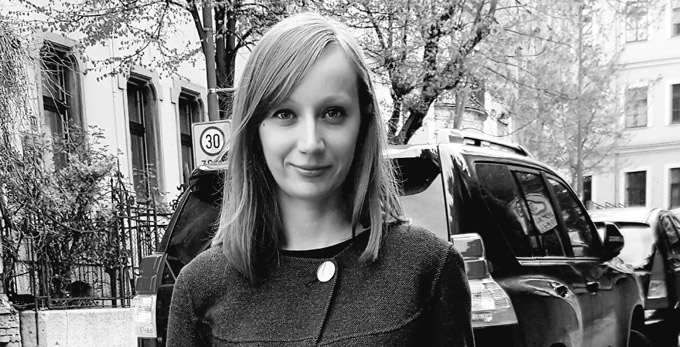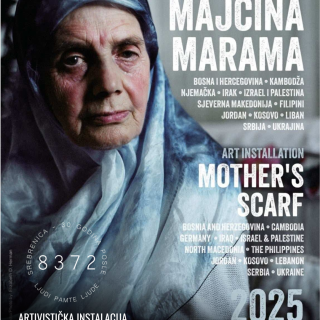While in a second it seemed that the ‘invisible enemy’ in BH did not choose between ethnicities, and that now, all Serbs and Bosniaks and Croats have a common enemy or danger – but, that second evaporated before sparking enough to feel any unity. ‘We haven’t learned anything,’ I heard somewhere. ‘All this is reminiscent of war,’ I also heard. And within the new fear regime, you would think that nobody is up to nationalisms. How wrong! However, you are, just to remind you that you are in BH. During the curfew in Mostar in April 2020, the Partisan Cemetery, one of the brilliant works of Bogdan Bogdanović, was again desecrated. Re-destruction as part of a systematically chosen approach to erasing an entire memory, erasing real people whose bodies are embedded in this monument to a once glorious past, a new outpouring of fascism in the madness of the corona. Because there is no curfew or pandemic for fascism.
Built in 1965, the Partisan Memorial Cemetery in Mostar is a symbol of anti-fascist resistance. During the war in Bosnia and Herzegovina, the monument suffered extensive damage. Today it is a "national monument", but there is no serious interest or either the will to rebuild or the care of the monument. Reconstruction was carried out several times, but devastation was the constant response, each time more severe and cruel. "Kill Balija"; "Tito the Vampire"; "Ustasha"; hooked crosses and Ustasha U are graffiti on the walls of the Partisan cemetery, past and present, on that former symbol of something common and great. The resistance that arises due to anti-fascist symbols and rhetoric in public space proves how strong the narrative is about new and exclusive national/ethnic identities. In Mostar, there seems to be no place for a shared past.
Without any ideological, regime sign or symbol, the Partisan Cemetery, or Partisan (as they call it), is based on the idea of freedom, abstract forms drawn from the universal symbolism of the elements of the sun, planets, and moon ("the monument becomes close to all people and manages to impose itself as authentic element of space ”), guided by Bogdanović’s dreams of two cities who look at each other: The city of the dead Mostar young men and girls and the city of the living Mostar, for whom the buried ones at Partisan gave their lives. "When someone asks what this symbol means, what is trying to say, it is always a wrong question. It’s always about what you see in it, "claimed the creator of this monumental building. Partizan, according to Bogdanović, is an open-air crypt that narrated the "myth of peace and freedom," "Mostar in the small version, a replica of the city on the Neretva River, its ideal diagram." The stone birds, tombstones with the inscribed names of the fallen partisans were repeatedly broken – restored – moved – returned – broken. How much destruction does it take to destroy the spirit and beauty of something that is part of the identity of the city, in which, besides the partisans’ bodies and stone from the old Mostar houses, is the Neretva stone from the city stream itself?
"The monument was built slowly, painstakingly, from voluntary contributions, even from contributions in kind (and "in kind" was a stone), and also from stone from the old Mostar houses, which had been greatly destroyed by time and urbanism, and families were happy to donated a stone branch. Even this quiet relocation of materials, including the substance of the old town, had symbolic value. The stone, often with centuries-old traces of smoke or clad in moss, with "house guards," transmitted from one time to another the particles of memory and the spirit of the respect, mixed with the overwhelming quantities of fresh limestone, white as cheese. " (To city of my friends)
Mostar, though, is no longer that city. Thus, the new-old past lives on the streets of Mostar, such as those named after Francetić and Budak. They are new heroes, new beginnings, and the city is no longer one. And the fallen partisans are no longer his, they are no one’s. Bogdanović was aware of the bitter truth – "It is certain that these monuments will not speak to the next generations in the same way as they tell us now, but it is important that they do not remain silent." I am afraid that silence is what is being attempted here. Delete the monument of liberty from the mental and physical map of the city. Whatever, of these we have now. Bogdanović notes that "all that remains of my original promise is that the former city of the dead and the former city of the living are still looking at each other, but with blank, black, burned eyes." Stone birds may be able to fly above all fascisms for which there is no curfew.
The author holds a PhD in law science, currently working as a legal advisor and independent researcher. Her areas of interest are dealing with the past with a focus on memory culture, human rights, constitutional law. She is the author of published articles, analytical, scientific and research papers in these fields.




